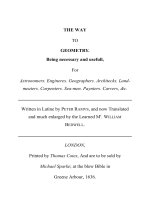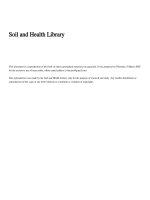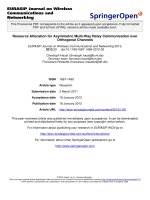Alt2-way
Bạn đang xem bản rút gọn của tài liệu. Xem và tải ngay bản đầy đủ của tài liệu tại đây (16.43 KB, 1 trang )
P
r
P
t
G
t
G
r
&
2
.
(4*)
3
R
4
P
t
G
t
G
r
.c
2
(4*)
3
f
2
R
4
(Note: &
c
f
and . is RCS)
4-5.1
ALTERNATE TWO-WAY RADAR EQUATION
In this section the same radar equation factors are grouped differently to create different constants as is used by some
authors.
TWO-WAY RADAR EQUATION (MONOSTATIC)
Peak power at the radar receiver input is:
[1]
* Keep & or c, ., and R in the same units. On reducing the above equation to log form we have:
or: 10log P = 10log P + 10log G + 10log G - (in dB)
r
t
t
r
2
Where: = 20log f R - 10log . + K , and K = -10log c /(4*)
2
1
3
3
2
23
Note: Losses due to antenna polarization and atmospheric absorption (Sections 3-2 and 5-1) are not included in these equations.
K Values:
3
(dB) Range f in MHz f in GHz f in MHz f in GHz
1
1
1
1
Units . in m . in m . in ft . in ft
2
2
2
2
NM 114.15 174.15 124.47 184.47
km 103.44 163.44 113.76 173.76
m -16.56 43.44 -6.24 53.76
yd -18.1 41.9 -7.78 52.22
ft -37.2 22.8 -26.88 33.12
In the last section, we had the basic radar equation given as equation [6] and it is repeated as equation [1] in the table
above.
In section 4-4, in order to maintain the concept and use of the one-way space loss coefficient, , we didn't cancel
1
like terms which was done to form equation [6] there. Rather, we regrouped the factors of equation [5]. This resulted
in two minus terms and we defined the remaining term as G , which accounted for RCS (see equation [8] & [9]).
1
.
Some authors take a different approach, and instead develop an entirely new single factor , which is used instead
2
of the combination of and G .
1
.
If equation [1] is reduced to log form, (and noting that f = c/&) it becomes:
10log P = 10log P + 10log G + 10log G - 20log (f R ) + 10log . + 10log (c /(4*)) [2]
r
t
t
r
2
23
We now call the last three terms on the right minus and use it as a single term instead of the two terms and G .
2
1
.
The concept of dealing with one variable factor may be easier although we still need to know the range, frequency
and radar cross section to evaluate . Additionally, we can no longer use a nomograph like we did in computing
2
1
and visualize a two-way space loss consisting of two times the one-way space loss, since there are now 3 variables vs
two.
Equation [2] reduces to: 10log P = 10log P + 10log G + 10log G - (in dB) [3]
r
t
t
r
2
Where = 20log (f R ) - 10log . + K and where f is the MHz or GHz value of frequency
2
1
3
1
2
and K = -10log (c /(4*) ) + 20log (conversion for Hz to MHz or GHz)+ 40log (range unit conversions if not
3
23
in meters) - 20log (RCS conversions for meters to feet)
The values of K are given in the table above.
3
Comparing equation [3] to equation [10] in Section 4-4, it can be seen that = 2 - G .
2
1
.









